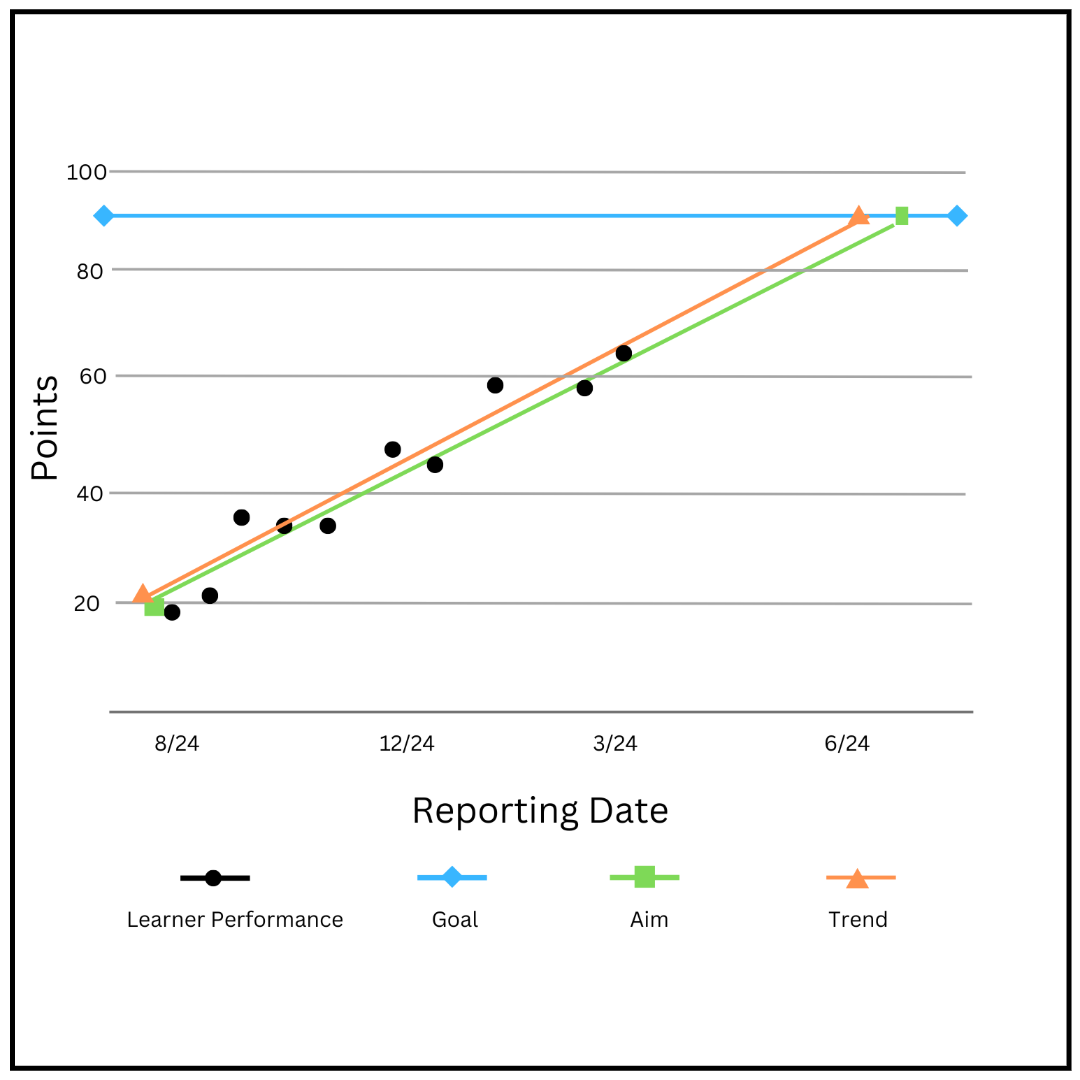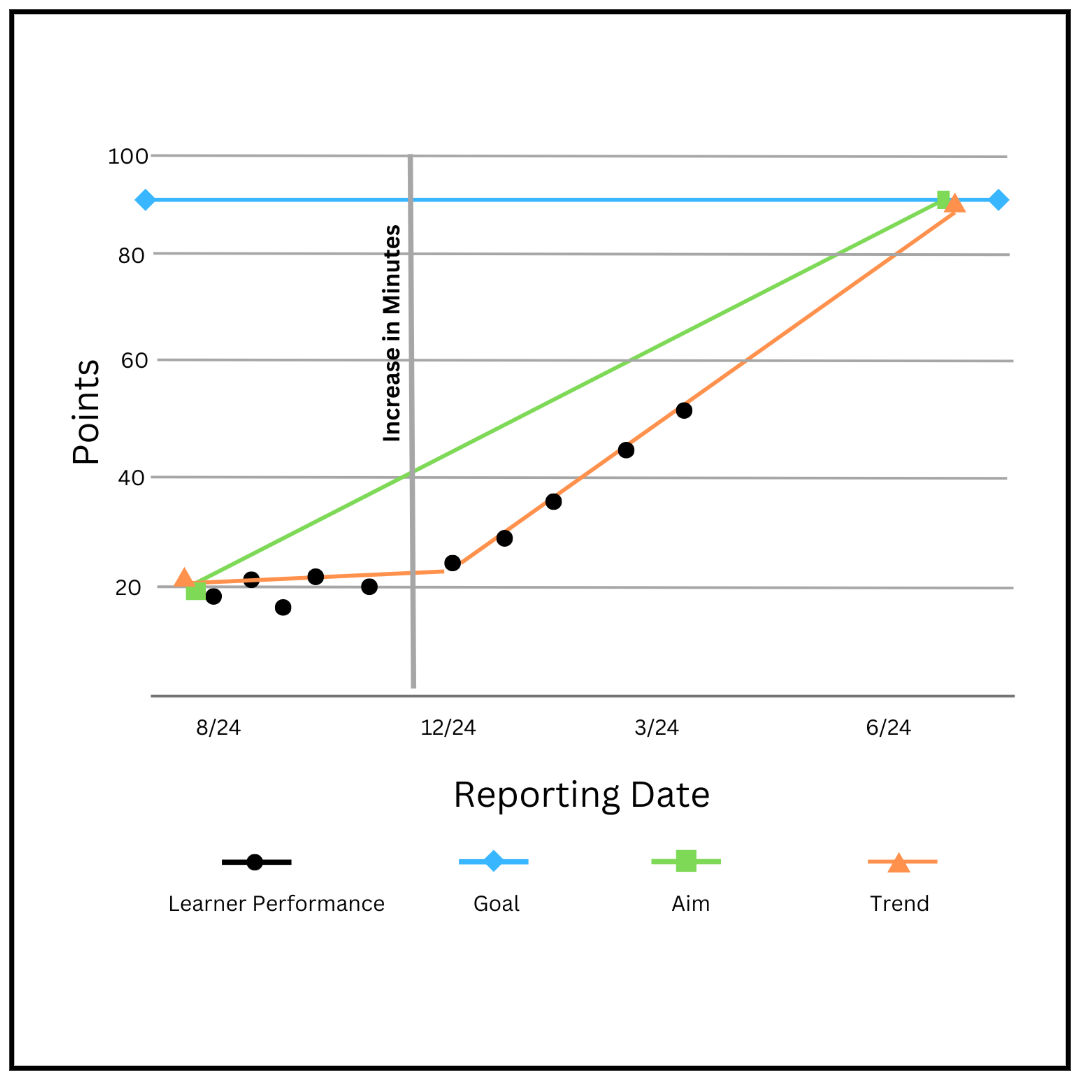CLICK HERE FOR PDF
Updated 10/10/2025
Progress Monitoring
Individualized Education Program (IEP) Goals
What is Progress Monitoring?
When a child becomes eligible for special education, the first step is for the school team to write an Individualized Education Program (IEP) with the family. The team creates goals for what the student will work on with the help of special education services. Data is collected for each goal to track progress regularly. This is progress monitoring.
The goal of the Individuals with Disabilities Education Act (IDEA) is to help children with disabilities make meaningful progress and reach goals that are challenging for them.
Supreme Court Ruling for Progress Monitoring
Endrew F. v. Douglas Co. Sch. Dist.
580 U.S. 386 (2017)
“...a school must offer an IEP reasonably calculated to enable a child to make progress appropriate in light of the child’s circumstances.”
What are the steps for progress monitoring?
Step 1. Special education providers collect data on the progress toward IEP goals.
The IEP team, including parents, should discuss how often data will be collected. How often the data is collected depends on what is being measured and how fast progress is expected. Behavior data could be collected daily. Academic data might be collected twice a month. It is important to consider how long it will take to collect enough data to guide instructional changes. For example, if data is only collected once a month, it would take almost a whole school year to gather enough data to make necessary changes to the IEP.
On each goal page, under the heading Progress Monitoring and Reporting, parents will see:
• How often progress will be measured (e.g., daily, weekly, bi-monthly).
• How often progress will be reported to parents.
• The way progress will be reported (e.g., an IEP Goal Progress Report)
Step 2. Compare the expected progress to what the student has scored.
In the ACHIEVE Family Portal, parents can easily see how the student is actually doing compared to what the IEP team expected. Each IEP goal will have a graph with a goal line, aim line, learner performance, and trend line. Parents should receive support from their IEP team to understand what each part of the graph means.
• Goal Line: This line shows the goal set by the team that the student is expected to reach.
• Aim Line: This line connects the baseline (starting) score to the ending goal. It shows expected growth throughout the year. Academic goals usually have an upward aim line when a student is making progress. Behavior goals may show a downward aim line, showing that a behavior is decreasing.
• Learner Performance: The student’s score is collected and recorded on the graph with a dot. Each dot shows the score on the date of collection. These dots create the trend line.
• Trend Line: This line shows the student’s actual progress over time. It will change as more data points are added. The trend line can be compared to the aim line to check if the student is on track to meet their goal.

This graph shows the learner is making progress with their goal. The upward trend line shows the student will probably reach their goal by the end date.
Step 3. Consider changes to teaching or support if the student regularly scores below, stays the same, or above the aim line.
If the student’s data points are outside the aim line or stay the same for several data collections in a row, it may mean the student is not making the progress the IEP team expected. The team should consider changes to instruction, materials, goals, and/or supports. These changes are marked on the graph as a phase line.
The student’s data could show that they are making progress faster than the IEP team expected. The IEP team should consider changing the goal to increase expectations for the student.
If the student meets their IEP goal, the team could consider setting a new goal or making the current one more difficult. If the student is scoring at the same level as their peers, a goal may no longer be needed in that area.

This graph shows that the learner struggled to progress with their goal. The phase line was added with “Increase in minutes.” The phase line highlights when a change was made and how it affected the data/student performance.
Why is progress monitoring important?
1. Tracks Student Performance: Progress monitoring helps IEP teams see how students are doing over time. It shows if the student is improving, staying the same, or not making appropriate progress.
2. Guides Instructional Changes: Based on the progress monitoring data, IEP teams can decide if changes are needed. This ensures the teaching is effective and meets each student’s needs.
How will I be informed of my child’s progress?
Progress Reports: Schools must send IEP Goal Progress Reports to parents as often as they send home report cards. For instance, if report cards are given every nine weeks, parents should also get IEP Goal Progress Reports at that time. Progress monitoring reports can be provided more frequently if needed.
ACHIEVE Family Portal: Iowa families who sign up for the ACHIEVE Family Portal can see their child’s progress as it is added to the system. More information about the ACHIEVE Family Portal can be found through your school, the Iowa Department of Education, or ASK Resource Center.
What are some tips for parents related to progress monitoring?
Progress monitoring is important because it shows how well students are progressing toward their goal(s). It is used to decide if changes to the IEP are needed. An IEP does not guarantee student progress. However, if a student is not making progress, the team must take action to ensure Free and Appropriate Public Education (FAPE). As a parent, you can help by:
- Understanding who is collecting the data for each goal and how they will be scored. The team might use a rubric or point sheet, for example.
- Staying up-to-date on your student’s data by making sure you receive regular progress reports from the school or by checking the ACHIEVE Family Portal.
- Asking questions if you don’t understand the data.
- Meeting with your student’s teacher or IEP team if you think they are not making enough progress.
Related Resources:
Search these titles at askresource.org/resources
- 6 Principles of IDEA
- FAQ From Families about IEPs
- FAPE
- ACHIEVE Family Portal from the Iowa Department of Education
ASK Essential Questions:
- How will the child’s progress be measured?
- When will the child’s progress be measured?
- Is my child on track to reach their goal(s)?
- How will I know if my child meets their goal(s)?
- When will instructional changes be considered?